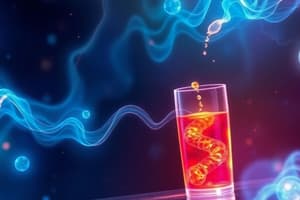Podcast
Questions and Answers
What is the study of drugs and their effects on living systems called?
What is the study of drugs and their effects on living systems called?
- Anatomy
- Pharmacology (correct)
- Biochemistry
- Physiology
Which of the following describes what the body does to a drug?
Which of the following describes what the body does to a drug?
- Pharmacodynamics
- Toxicology
- Pharmacokinetics (correct)
- Therapeutics
What does 'ADME' stand for in pharmacology?
What does 'ADME' stand for in pharmacology?
- Action, Dosage, Management, Effect
- Absorption, Distribution, Metabolism, Excretion (correct)
- Analysis, Development, Manufacturing, Evaluation
- Administration, Dissolution, Modification, Elimination
Which process describes how a drug enters the bloodstream?
Which process describes how a drug enters the bloodstream?
Where does drug metabolism primarily occur?
Where does drug metabolism primarily occur?
What is the process called by which a drug is removed from the body?
What is the process called by which a drug is removed from the body?
What are proteins that bind drugs to mediate their effects called?
What are proteins that bind drugs to mediate their effects called?
What is a drug that activates a receptor called?
What is a drug that activates a receptor called?
What is a drug that blocks a receptor called?
What is a drug that blocks a receptor called?
What is the study of the adverse effects of drugs?
What is the study of the adverse effects of drugs?
An inactive drug that is metabolized into an active form is called?
An inactive drug that is metabolized into an active form is called?
The fraction of an administered dose of a drug that reaches the systemic circulation is known as:
The fraction of an administered dose of a drug that reaches the systemic circulation is known as:
What is the measure of drug safety, represented by the ratio TD50/ED50?
What is the measure of drug safety, represented by the ratio TD50/ED50?
What term describes a decreased response to a drug with repeated use?
What term describes a decreased response to a drug with repeated use?
What type of drug administration involves application to the skin for local effects?
What type of drug administration involves application to the skin for local effects?
What is Phase I of clinical trials primarily designed to assess?
What is Phase I of clinical trials primarily designed to assess?
What is the main purpose of using drugs in therapeutics?
What is the main purpose of using drugs in therapeutics?
The time it takes for the plasma concentration of a drug to decrease by half is called:
The time it takes for the plasma concentration of a drug to decrease by half is called:
Which route of administration provides the most rapid onset of drug action?
Which route of administration provides the most rapid onset of drug action?
What term describes the use of multiple medications by a single patient?
What term describes the use of multiple medications by a single patient?
Flashcards
Pharmacology
Pharmacology
The study of drugs and their effects on living systems, including ADME, mechanisms of action, and therapeutic/toxic effects.
Pharmacokinetics (ADME)
Pharmacokinetics (ADME)
What the body does to the drug, involving absorption, distribution, metabolism, and excretion.
Bioavailability
Bioavailability
The fraction of an administered drug dose that reaches the systemic circulation.
Distribution
Distribution
Signup and view all the flashcards
Volume of Distribution (Vd)
Volume of Distribution (Vd)
Signup and view all the flashcards
Metabolism
Metabolism
Signup and view all the flashcards
Prodrugs
Prodrugs
Signup and view all the flashcards
Excretion
Excretion
Signup and view all the flashcards
Half-life (t1/2)
Half-life (t1/2)
Signup and view all the flashcards
Receptors
Receptors
Signup and view all the flashcards
Agonists
Agonists
Signup and view all the flashcards
Antagonists
Antagonists
Signup and view all the flashcards
Partial agonists
Partial agonists
Signup and view all the flashcards
Efficacy
Efficacy
Signup and view all the flashcards
Potency
Potency
Signup and view all the flashcards
Therapeutic Index (TI)
Therapeutic Index (TI)
Signup and view all the flashcards
ED50
ED50
Signup and view all the flashcards
TD50
TD50
Signup and view all the flashcards
Tolerance
Tolerance
Signup and view all the flashcards
Pharmacogenomics
Pharmacogenomics
Signup and view all the flashcards
Study Notes
- Pharmacology is the study of drugs and their effects on living systems.
- It encompasses how drugs are absorbed, distributed, metabolized, and excreted (ADME), as well as their mechanisms of action and therapeutic and toxic effects.
Core Principles
- Pharmacokinetics: What the body does to the drug (ADME).
- Pharmacodynamics: What the drug does to the body (mechanism of action and effects).
- Therapeutics: The use of drugs to diagnose, prevent, or treat disease.
- Toxicology: The study of the adverse effects of drugs and other chemicals.
Pharmacokinetics (ADME)
- Absorption: The process by which a drug enters the bloodstream.
- Routes of administration affect absorption (e.g., oral, intravenous, intramuscular, subcutaneous, transdermal).
- Bioavailability: The fraction of the administered dose of a drug that reaches the systemic circulation.
- Distribution: The process by which a drug spreads throughout the body.
- Factors affecting distribution: blood flow, tissue permeability, protein binding, and tissue binding.
- Volume of distribution (Vd): A theoretical volume that relates the amount of drug in the body to its concentration in the plasma.
- Metabolism: The process by which a drug is chemically altered in the body.
- Primarily occurs in the liver.
- Phase I reactions: Oxidation, reduction, and hydrolysis (often involving cytochrome P450 enzymes).
- Phase II reactions: Conjugation (e.g., glucuronidation, sulfation).
- Prodrugs: Inactive compounds that are metabolized into active drugs.
- Excretion: The process by which a drug is removed from the body.
- Primarily occurs via the kidneys (urine) and liver (bile/feces).
- Clearance: The rate at which a drug is removed from the body.
- Half-life (t1/2): The time it takes for the plasma concentration of a drug to decrease by half.
Pharmacodynamics
- Receptors: Proteins that bind drugs and mediate their effects.
- Agonists: Drugs that activate receptors.
- Antagonists: Drugs that block receptors.
- Competitive antagonists bind reversibly to the same site as the agonist.
- Noncompetitive antagonists bind irreversibly or to a different site.
- Partial agonists: Drugs that activate receptors but produce a submaximal response.
- Inverse agonists: Drugs that bind to receptors and produce an effect opposite to that of an agonist.
- Dose-response relationship: The relationship between the dose of a drug and the response.
- Efficacy: The maximum effect a drug can produce.
- Potency: The amount of drug required to produce a certain effect.
- Therapeutic index (TI): A measure of drug safety (TD50/ED50).
- TD50: The dose that produces a toxic effect in 50% of the population.
- ED50: The dose that produces a therapeutic effect in 50% of the population.
- Signal transduction: The process by which a drug's binding to a receptor leads to a cellular response.
- G protein-coupled receptors (GPCRs)
- Ion channels
- Enzyme-linked receptors
- Intracellular receptors
Drug Classes
- Cardiovascular drugs:
- Antihypertensives (e.g., ACE inhibitors, beta-blockers, calcium channel blockers)
- Antiarrhythmics (e.g., sodium channel blockers, potassium channel blockers)
- Antianginals (e.g., nitrates, beta-blockers, calcium channel blockers)
- Heart failure drugs (e.g., ACE inhibitors, diuretics, beta-blockers, digoxin)
- Lipid-lowering drugs (e.g., statins, fibrates)
- Central nervous system (CNS) drugs:
- Antidepressants (e.g., SSRIs, SNRIs, TCAs, MAOIs)
- Antipsychotics (e.g., typical, atypical)
- Anxiolytics (e.g., benzodiazepines, SSRIs)
- Hypnotics (e.g., benzodiazepines, non-benzodiazepines)
- Antiepileptics (e.g., phenytoin, carbamazepine, valproic acid)
- Antiparkinsonian drugs (e.g., levodopa, dopamine agonists)
- Analgesics (e.g., opioids, NSAIDs)
- Endocrine drugs:
- Antidiabetic drugs (e.g., insulin, metformin, sulfonylureas)
- Thyroid hormones (e.g., levothyroxine)
- Antithyroid drugs (e.g., methimazole, propylthiouracil)
- Corticosteroids (e.g., prednisone, hydrocortisone)
- Sex hormones (e.g., estrogens, progestins, androgens)
- Anti-inflammatory drugs:
- NSAIDs (e.g., ibuprofen, naproxen)
- Corticosteroids (e.g., prednisone)
- Disease-modifying antirheumatic drugs (DMARDs) (e.g., methotrexate)
- Antimicrobial drugs:
- Antibiotics (e.g., penicillins, cephalosporins, macrolides, tetracyclines)
- Antivirals (e.g., acyclovir, oseltamivir)
- Antifungals (e.g., azoles, amphotericin B)
- Antiparasitics (e.g., metronidazole, mebendazole)
- Chemotherapeutic drugs:
- Alkylating agents (e.g., cyclophosphamide)
- Antimetabolites (e.g., methotrexate)
- Topoisomerase inhibitors (e.g., doxorubicin)
- Microtubule inhibitors (e.g., paclitaxel)
- Targeted therapies (e.g., tyrosine kinase inhibitors)
Factors Influencing Drug Response
- Age: Infants and elderly individuals often have altered drug metabolism and excretion.
- Genetics: Genetic variations can affect drug metabolism and receptor sensitivity.
- Disease: Liver or kidney disease can affect drug metabolism and excretion.
- Drug interactions: Drugs can interact with each other, altering their effects.
- Additive effects: The combined effect is equal to the sum of the individual effects.
- Synergistic effects: The combined effect is greater than the sum of the individual effects.
- Antagonistic effects: One drug reduces the effect of another.
- Tolerance: Decreased response to a drug with repeated use.
- Dependence: Physiological or psychological need for a drug.
- Placebo effect: A response to a drug that is not due to its pharmacological effect.
Drug Development
- Preclinical testing: In vitro and in vivo studies to assess drug safety and efficacy.
- Clinical trials: Studies in humans to evaluate drug safety and efficacy.
- Phase I: Small number of healthy volunteers to assess safety and pharmacokinetics.
- Phase II: Small number of patients with the target disease to assess efficacy and dose-ranging.
- Phase III: Large, randomized, controlled trials to confirm efficacy and monitor adverse effects.
- Phase IV: Post-marketing surveillance to monitor long-term safety and effectiveness.
Toxicology
- Adverse drug reactions (ADRs): Undesirable effects of drugs.
- Type A reactions: Predictable and dose-dependent (e.g., side effects).
- Type B reactions: Unpredictable and not dose-dependent (e.g., allergic reactions).
- Drug interactions: Can lead to increased toxicity.
- Overdose: Excessive dose of a drug, leading to toxic effects.
- Treatment of poisoning:
- Supportive care (e.g., airway, breathing, circulation).
- Decontamination (e.g., activated charcoal, gastric lavage).
- Antidotes (e.g., naloxone for opioid overdose).
Special Populations
- Pediatric Pharmacology:
- Differences in drug absorption, distribution, metabolism, and excretion.
- Dosing often based on weight or body surface area.
- Geriatric Pharmacology:
- Age-related changes in organ function.
- Increased risk of adverse drug reactions and drug interactions.
- Polypharmacy: The use of multiple medications.
- Pregnancy and Lactation:
- Drugs can cross the placenta and affect the fetus.
- Some drugs can be excreted in breast milk and affect the infant.
- Risk-benefit ratio must be carefully considered.
Routes of Administration
- Enteral:
- Oral: Simplest, but absorption can be variable.
- Sublingual: Rapid absorption, avoids first-pass metabolism.
- Rectal: Useful for patients who cannot swallow.
- Parenteral:
- Intravenous (IV): Rapid onset, precise control of drug concentration.
- Intramuscular (IM): Slower absorption than IV, but faster than subcutaneous.
- Subcutaneous (SC): Slower absorption than IM.
- Transdermal: Slow, sustained release through the skin.
- Other:
- Inhalation: Rapid absorption for respiratory drugs.
- Topical: Local effects on the skin or mucous membranes.
Drug Regulation
- Regulatory agencies:
- Food and Drug Administration (FDA)
- European Medicines Agency (EMA)
- Drug scheduling:
- Controlled substances are classified based on their potential for abuse.
Precision Medicine
- Pharmacogenomics: The study of how genes affect a person's response to drugs.
- Personalized medicine: Tailoring drug therapy to an individual's genetic makeup, lifestyle, and environment.
Studying That Suits You
Use AI to generate personalized quizzes and flashcards to suit your learning preferences.




